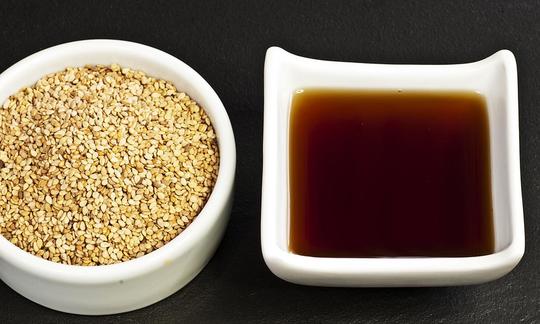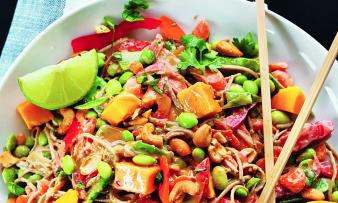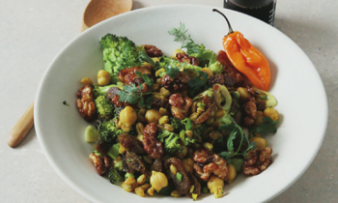Table of contents
Dark sesame oil is obtained from roasted sesame seeds, while light sesame oil is pressed from the natural seeds of the sesame ( Sesamum indicum). Sesame oil has a very unfavorable ratio of omega-6 to omega-3 fatty acids, which is why it should only be used sparingly in the kitchen.
Use in the kitchen
Roasted sesame oil is a strongly spicy cooking oil and is mainly used in Asian and oriental cuisine. It has a relatively dark appearance and can range in color from amber to brown.
The nutty aroma can quickly mask the taste of other ingredients, so it should be used sparingly. Roasted sesame oil goes well as a seasoning oil with hearty rice, millet, soy and wok dishes, but it also gives desserts and crisp salads a distinctive note. Peanut oil and walnut oil are also popular as seasoning oils.
Roasted sesame oil has a typical nutty, popcorn-like smell that we find very pleasant. 7 This is the result of the roasting process. However, during the so-called Maillard reaction, undesirable, health-hazardous substances such as acrylamide can form. Therefore, the oil should only be used occasionally.
Vegan recipe for Korean cucumber salad with sesame oil
Ingredients (for approx. 4 people): 450 g cucumbers, 1 small red onion, 1⁄2 tsp brown sugar, 1⁄2 tsp chili flakes, 1 tsp toasted sesame oil, 1 tsp soy sauce, 1 tsp rice vinegar, some sesame seeds.
Preparation : Wash the cucumbers, halve them, remove the seeds if necessary, and cut into thin strips about 4-5 cm long. Put all the ingredients except the sesame seeds in a bowl and mix well. Leave the dish in the fridge for about 20 minutes and sprinkle with sesame seeds before serving.
For more recipes using toasted sesame oil, see the link: " Recipes that make the most of this ingredient ".
| Not only vegans or vegetarians should read this: Vegans often eat unhealthily. Avoidable nutritional errors. |
Purchasing - Storage
Roasted sesame oil is available in selected supermarkets such as Coop, Migros, Spar, Rewe, Billa or Edeka as part of the standard range. Denner, Volg, Aldi, Lidl, Hofer etc. occasionally sell roasted sesame oil as part of special promotions. Roasted sesame oil can often be found in Asian shops.
Prefer roasted sesame oil from organic production, as sesame tends to absorb heavy metals from the soil. This is an even bigger problem in conventional agriculture due to the fertilizers used. 3 Organically produced sesame oil can be found in organic shops, organic supermarkets (e.g. Alnatura or Denn's Biomarkt), health food stores or online.
Although roasted sesame oil is also referred to as virgin in the trade, this is questionable. Due to the roasting process and the associated elevated temperatures, neither the term "cold pressing" nor the adjective "virgin" is appropriate. If the seeds are roasted before pressing, the oil no longer has the cold-pressed "naturalness" or the term "virgin", even if the seeds are gently pressed after roasting. The situation is similar with pumpkin seed oil.
Sesame oil from unroasted sesame seeds has a light, yellowish color. It can be cold-pressed (virgin) or refined.
The availability of roasted sesame oil varies depending on the size of the store, catchment area, etc. You can find our recorded food prices for the DA-CH countries above under the ingredient image - and by clicking you can see their development at various suppliers.
Cold-pressed oils (laws, raw food)
In Switzerland, oil is referred to as cold-pressed oil if the oilseed was not heated, the pressing temperature did not exceed 50 °C and no problematic post-treatment took place.
According to the Federal Department of Home Affairs ( FDHA), an edible oil is considered cold-pressed (or may be described with synonyms such as (extra) virgin, unrefined, cold-pressed or natural) if it has been obtained by pressing or centrifuging from previously unheated raw materials, the temperature during pressing did not exceed 50 °C and it has not been subjected to refining, i.e. no neutralisation, no treatment with adsorbents, bleaching earth or steaming.
An oil may be described as “gently steamed” if the refining process was limited to steaming and the temperature did not exceed 130 °C. 20
In the EU and the USA, there does not seem to be a generally applicable temperature limit for cold-pressed oils. The guidelines for edible fats and oils of the Federal Ministry of Food and Agriculture (Germany) and the EDI regulation are worded similarly. However, they do not specify a permissible maximum temperature for general cold pressing. These regulations only apply to products whose labelling and composition are not conclusively defined by law, such as olive oil, cocoa butter, milk fats and spreads. 21
On the other hand, both the EU directives and the amendment to the EDI regulation on foods of plant origin, mushrooms and table salt (and its amendment) provide for a special rule for the labelling of olive oils. 22,23
These are selective marketing rules in which the term raw food is not defined. "Raw food" and "raw" are therefore not state-protected terms (as is the case with the term "organic"), which leaves a lot of room for interpretation. Although it is agreed that with purely mechanical cold pressing, the pressing temperatures generally do not exceed 40 °C, one should not naively assume that cooking oils are raw food quality. There is a suspicion that the measuring method used does not indicate the temperature in the press cylinder (where the heat is highest), but only the outlet temperature in the oil hose. With water-cooled olive oil presses (so-called "water-cooled 37°" oil presses), one probably cannot even say with certainty what the exact temperature is inside the press cylinder, because the entire press cylinder is surrounded by cooling sleeves.
In addition, the pressing pressure and speed as well as the moisture content of the oilseed affect the pressing temperature. If, for example, the moisture content is too low, the temperature rises during pressing and it is difficult to stay even below the maximum limit of 50 °C. 24
Storage tips
The antioxidants sesamolin and sesamol contained in roasted sesame oil protect the oil from reacting with light and oxygen. Even cold-pressed roasted sesame oil is not very susceptible. Nevertheless, it is advisable to store it in a cool place away from light so that the roasted sesame oil can be stored for up to a year. 7
Ingredients - Nutritional values - Calories
Due to the high variability of nutrients depending on the roasting process, extraction method, origin and quality of the sesame seeds as well as the respective environmental and harvesting conditions, we have adopted the ingredients from the unroasted version of sesame oil. In addition, the available basic information (proportion of saturated and unsaturated fatty acids) of commercial roasted sesame oils largely corresponds to that of unroasted sesame oils.
Sesame oil consists exclusively of fat and has a calorie content of 884 kcal/100g. 26 The proportion of saturated fats is about 14%, the unsaturated fatty acids predominate: polyunsaturated fatty acid ( linoleic acid) with about 41%, monounsaturated fatty acid (oleic acid) with about 38% (fluctuation range between 28 and 44% 8), < 1% polyunsaturated fatty acid ( alpha-linolenic acid). Sesame oil also contains palmitic acid, myristic acid, stearic acid, etc. 8
According to a study from 2001, the composition of fatty acids and tocopherols in roasted sesame oil only changes at roasting temperatures of around 220 to 240 °C. 4 A study from 2012 also indicates that the unsaturated fatty acids in roasted sesame seeds hardly change. 9 However, studies from 2017 do show changes in the unsaturated fatty acids of roasted sesame seeds (the proportion of oleic acid, palmitic acid and stearic acid increases, the proportion of linoleic acid decreases slightly) - compared to unroasted seeds. 10 In particular, roasting for 10 minutes at 180 °C leads to a slight decrease in polyunsaturated fatty acids, which are somewhat more sensitive to heat. 11 A study by Colin Crews et al. provides the following information in terms of essential fatty acids in % total: Unroasted (LA 36.9-47.8; ALA 0.2-1) vs. roasted (LA 38.8-43.9; ALA 0.3). 25
Sesame oil does not contain many vitamins, but two of them are detectable. Vitamin K is present in sesame oil at 14 µg/100g. Walnut oil has a similar content (15 µg), and rapeseed oil has a multiple of that at over 70 µg. 26
Vitamin E (alpha-tocopherol) is only contained in sesame oil at 1.4 mg/100g. Compared to healthier oils, linseed oil has less (0.06 mg/100g), whereas rapeseed oil has much more (17 mg/100g). 26
The ingredients of roasted sesame oil, the coverage of the daily requirement and comparison values with other ingredients can be found in our nutrient tables. In the article Nutrients explained you will get a detailed insight into the topic.
Health effects
Is roasted sesame oil healthy? Studies of components of sesame oil show positive effects in in vitro and in vivo tests. The antioxidant sesamol is formed from sesamolin, which is present in sesame oil at 0.3 to 0.5% and is said to have health-promoting properties. 12 Sesamol has a remarkable oxidation stability even when roasted at over 220 °C, whereas sesamolin was hardly present after about 25 minutes of roasting. 6 Sesamin is also said to lead to a reduction in LDL cholesterol. 30
Such studies suggest an added value for health. Please remember, however, that every oil consists of almost 100% fat. The health-promoting components it contains are very small, relative to the amount you consume daily.
The most important criteria for assessing an oil as "healthy" or "unhealthy" are the content of unsaturated fatty acids and the ratio between omega-6 fatty acids and omega-3 fatty acids. Roasted sesame oil consists of almost 100% fat and should only be used sparingly due to its high energy content. The ratio between omega-6 fatty acids (linoleic acid) and omega-3 fatty acids (alpha-linolenic acid) is very unfavorable at 138:1. The predominant linoleic acid promotes inflammation in the body.
According to Dr. Michael Greger, the ideal omega-6 to omega-3 ratio is 1:1 in order to maintain a balance between the two conversion processes in the body. The guidelines of the Federal Nutrition Commission (EEK) are less strict and recommend reducing the ratio to at least 5:1. 28 Therefore, instead ofsunflower oil, you should use linseed oil (1:4), walnut oil (5:1) and cold-pressed rapeseed oil (2:1) for cold dishes and refined rapeseed oil for frying and cooking, which have a good omega-6 to omega-3 ratio.
It is even healthier not to consume oil, but to eat seeds and nuts instead. All oils are concentrated foods that have been through various processing steps. In general, whole, unprocessed foods such as nuts or seeds are preferable. Various American doctors, including heart specialists, take an even stricter approach, rejecting oil on principle and recommending switching to nuts and seeds. We are talking about Dean Ornish, T. Colin Campbell, John A. McDougall, Michael Klaper, Caldwell Esselstyn, Michael Greger, Joel Fuhrman and Neal D. Barnard, who basically explain that a diet high in animal fats and proteins (like the standard American diet) is bad for your health.
Secondary plant substances
Many of the health effects of roasted sesame oil can be attributed to the secondary plant substances it contains. Our article on secondary plant substances provides an overview of the classification of substance groups, their occurrence in foods and possible effects on humans.
However, it should be noted that the composition of secondary plant substances in roasted sesame oil can vary depending on the variety, time of harvest and growing conditions. Therefore, quantities are only of limited use and should only be understood roughly.
Dangers - Intolerances - Side effects
The roasting process has negative effects. Heat-sensitive vitamins are lost during roasting and the Maillard reaction that takes place increases the acrylamide content. 13 Today, people tend to write about glycosylation and the reaction product Advanced Glycation Endproduct (AGE). In addition, the formation of trans fats during heating is very likely due to the unsaturated fatty acids present.
Since sesame is one of the strong allergens that must be declared, this also applies to sesame oil. However, there are only very few people who are allergic to it (0.1%). 27 There are also reactions to the oil in the form of allergic contact eczema. Lignin-like ingredients probably trigger the skin irritation. 29
Ecological footprint - animal welfare
The CO 2 footprint is primarily used to assess the climate friendliness of a food. This depends on various aspects such as cultivation method (conventional/organic), seasonality, country of origin, processing, transport and, if applicable, packaging. Carbon Cloud gives values of 2.6 kg and 5.44 kg CO 2 eq/kg for sesame oil. 2
The water footprint of sesame oil is very high at 21,793 l/kg. In comparison, rapeseed oil has 4301 l/kg, sunflower oil 6792 l/kg and olive oil 14,431 l/kg. 14
For detailed explanations of various sustainability indicators (such as ecological footprint, CO2 footprint, water footprint), see our article: What does the ecological footprint mean?
Animal welfare - species protection
Bees are important for a high yield in the cultivation of sesame and cotton. Biologist Dr. Katharina Stein from the University of Rostock came to this conclusion during a study in West Africa. Targeted pollination can increase yields by up to 60%. But wild and honey bees are also at risk in the tropics and without them there could be harvest losses of up to 59% for sesame. 18
Worldwide occurrence - cultivation
Sesame is one of the oldest oil plants used by humans. A genetic center cannot be clearly assigned to sesame. It is believed that it originated in southeast Africa, as many wild species can still be found there today. A domestication of Sesamum indicum from 2350 BC was found in the Middle East, more precisely in the former Mesopotamia (Mesopotamia). 15 Today, sesame plants are grown in many tropical and subtropical regions. There are white, yellow-brown, reddish or black sesame seeds.
The main producer of sesame oil is China. In 2021, Chinese manufacturers produced 267,900 tonnes. Other large producers are found in Myanmar (131,400 tonnes) and India (88,700 tonnes). 31 Global production of sesame oil in 2021 was around 1.02 million tonnes. This is only a small production volume compared to palm oil (80.58 million tonnes) and soybean oil (61.57 million tonnes). 1
Cultivation - Harvest
Sesame requires very warm, sunny locations with nutrient-rich, permeable soil. The rapid growth of this oil plant makes it very popular in tropical areas. In addition, the taproot, which reaches up to 1 m deep into the soil, helps it survive dry periods. 15 The annual sesame plant reaches a height of 1 to 1.5 m, depending on the variety. 16
The fruits are 3-4 cm long capsules that contain around 80-100 seeds with a maximum diameter of 3 mm. After 120 days of constant temperatures of over 25 °C, the seeds are ready for harvest. The capsules, which ripen very irregularly, burst open, and unfortunately many seeds are lost before harvest. The plants are therefore harvested before they are fully ripe and hung up to dry. 17 The seeds are usually harvested by hand. The capsules are cut off, dried and the seeds are then shaken out. 7
Industrial production
After the sesame seeds have been freed of impurities, they are treated with steam to promote the separation of the oil. To produce dark sesame oil, the sesame seeds are roasted and rehydrated with steam after roasting. Common roasting methods are infrared roasting or electric oven, as well as hot air roasting, which is the most commonly used due to its low cost. 7
For lightly roasted sesame oil, roasting takes place at 150 °C, for strongly roasted oil at around 180 °C. 7 The roasting time is between 10 and 30 minutes. According to a study, roasting at 140 to 180 °C is still considered acceptable for the aroma. Sesame oil roasted at 200 °C smells "burnt" to the European nose and is no longer digestible. 4 Higher roasting temperatures of over 220 °C produce a stronger aroma, but impair the quality. 5,6
The oil is extracted by pressing or extraction. The pressed oil is of better quality, but extraction can achieve a yield of almost 100%. The oil is then refined (cleaned and refined). 7
Further information
Dark sesame oil is made from roasted seeds of black and white sesame ( Sesamum indicum). This belongs to the sesame family (Pedaliaceae) and is probably one of the oldest oil plants in the world.
In addition to the roasted sesame oil variant, there is the much milder tasting, light sesame oil, which is made from unroasted sesame seeds.
Black sesame ( Sesamum indicum nigrum) was once considered a separate species of sesame, but today it is considered a colored variety of Sesamum indicum.
Alternative names
An alternative name for sesame oil is gingel oil.
In English it is called sesame oil, til oil, benne oil or gingelly. You can also find the term gingili for Indian sesame. 19
Other applications
The skin-care properties, the special composition and the delicate scent of sesame oil also make it interesting for the cosmetics and perfume industry. Sesame oil is a component of skin care products, is used in the production of vegetable soaps, as an additive in soaps and as a lubricant. 19
The press residue, known as sesame cake, is a very high-quality animal feed due to its high protein content of 40%. 15
Bibliography - 30 Sources
| 1. | FAOSTAT. Food and Agriculture Organization of the United Nations. Oil of sesame seeds, Palm oil, Soya bean oil. Production Quantity, 2021. |
| 2. | Carbon Cloud. 100% Pure Sesame Oil (USA). Sesam Oil (Netherlands). |
| 3. | Pini U. Das Bio-Food Handbuch. Ullmann: Hamburg, Potsdam. 2014. |
| 4. | Kim JS. Einfluss der Temperatur beim Rösten von Sesam auf Aroma und antioxidative Eigenschaften des Öls. Dissertation. Technische Universität Berlin. 2001. |
| 5. | Ryu SN, Kim SM et al. Influence of seed roasting process on the changes in volatile compounds of the sesame (Sesamum Indicum L.) oil. In: Shahidi F, Ho CT (Eds.) Flavor Chemistry of Ethnic Foods. Springer: Boston; 1999: 229-237. |
| 6. | Yoshida H, Takagi S. Effects of seed roasting temperature and time on the quality characteristics of sesame (Sesamum indicum) oil. Journal of the Science of Food and Agriculture. 1999;75(1):19-26. |
| 7. | Krist S. Sesamöl/Sesamöl. In: Krist S (Ed.) Lexikon der pflanzlichen Fette und Öle. Springer; 2013: 727-740. |
| 8. | Haynes WM. CRC Handbook of Chemistry and Physics. 95. Auflage. CRC Press. 2014. |
| 9. | Hassan MAM. Studies on Egyptian Sesame Seeds (Sesamum indicum L.) and Its Products 1- Physicochemical Analysis and Phenolic Acids of Roasted Egyptian Sesame seeds (Sesamum indicum L.). World Journal of Dairy & Food Sciences. 2012;7(2):195-201. |
| 10. | Hama JR. Comparison of fatty acid profile changes between unroasted and roasted brown sesame (Sesamum indicum L.) seeds oil. Journal of Food Properties. 2017;20(5):957-967. |
| 11. | Tenyang N, Ponka R et al. Effects of boiling and roasting on proximate composition, lipid oxidation, fatty acid profile and mineral content of two sesame varieties commercialized and consumed in Far-North Region of Cameroon. Food Chemistry. 2017;221:1308-1316. |
| 12. | Kumar CM, Sathisha UV et al. Interaction of sesamol (3,4-methylenedioxyphenol) with tyrosinase and its effect on melanin synthesis. Biochimie. 2011;93(3):562-569. |
| 13. | Berk E, Hamzalıoğlu A, Gökmen V. Investigations on the maillard reaction in sesame (Sesamum indicum L.) seeds induced by roasting. J Agric Food Chem. 2019;67(17):4923-4930. |
| 14. | Mekonnen MM, Hoekstra AY. The green, blue and grey water footprint of crops and derived crop products. Hydrol Earth Syst Sci. 2011;15(5):1577–1600. |
| 15. | Brücher H. Tropische Nutzpflanzen. Ursprung, Evolution und Domestikation. Springer: Berlin, Heidelberg, New York. 1977. |
| 16. | Pahlow. M. Das grosse Buch der Heilpflanzen. Gesund durch die Heilkräfte der Natur. Nikol: Hamburg. 2013. |
| 17. | Rehm S, Espig G. Die Kulturpflanzen der Tropen und Subtropen. Anbau, wirtschaftliche Bedeutung, Verwertung. Eugen Ulmer: Stuttgart. 1976. |
| 18. | Stein K, Coulibaly D et al. Bee pollination increases yield quantity and quality of cash crops in Burkina Faso, West Africa. Scientific Reports. 2017;7:17691. |
| 19. | Bown D. Encyclopedia of Herbs & their uses. DK: London. 1996. |
| 20. | Eidgenössisches Departement des Innern. Verordnung des EDI über Speiseöl, Speisefett und daraus hergestellte Erzeugnisse vom 23. November 2005 (Stand am 9. April 2015). |
| 21. | Bundesministerium für Ernährung und Landwirtschaft. Leitsätze für Speisefette und Speiseöle. Neufassung vom 02.07.2020 (BAnz AT 18.08.2020 B3, GMBl 2020 S. 530). |
| 22. | Amtsblatt der Europäischen Union. Durchführungsverordnung (EU) Nr. 29/2012 der Kommission vom 13. Januar 2012 mit Vermarktungsvorschriften für Olivenöl. Artikel 5 a) und b). |
| 23. | Eidgenössisches Departement des Innern. Verordnung des EDI über Lebensmittel pflanzlicher Herkunft, Pilze und Speisesalz (VLpH). Änderung vom 8. Dezember 2023. Inkrafttreten: 1. Februar 2024. |
| 24. | Schaufler D. Oilseed Fact Sheet: Oilseed Presses. Dept. of Agricultural and Biological Engineering, Penn State College of Agricultural Sciences. |
| 25. | Crews C, Hough P, Brereton P et al. Quantitation of the main constituents of some authentic sesame seed oils of different origin. J Agric Food Chem. 2006;54(17):6266-6270. |
| 26. | USDA United States Department of Agriculture. |
| 27. | Dalal I, Goldberg M, Katz Y. Sesame Seed Food Allergy. Current Allergy and Asthma Reports. 2012;12(4). |
| 28. | Schweizerische Eidgenossenschaft EKK Eidgenössische Ernährungskommission. Fette in der Ernährung. 2006. |
| 29. | Gangur V. Kelly C, Navuluri L. Sesame allergy: a growing food allergy of global proportions? Annals of Allergy, Asthma and Immunology. 2005;95(1). |
| 30. | Biesalski HK, Bischoff Sc, Pirlich M et al. Ernährungsmedizin. 5. Auflage. Thieme: Stuttgart, New York. 2018. |











Comments